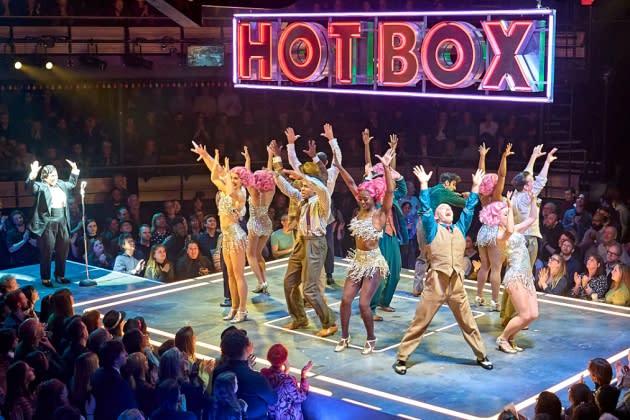‘Guys and Dolls’ Review: An Explosively Thrilling Production of a Masterpiece in London
- Oops!Something went wrong.Please try again later.

Since Nicholas Hytner, former artistic director of the National Theatre, is one of the finest, most detailed Shakespeare directors in the land, you could be forgiven for forgetting that he really knows how to put on a show — and then some. Given that his career spans everything from “One Man, Two Guvnors” to the original “Miss Saigon,” expectations in London were high that, armed with arguably the greatest musical comedy ever written, he might be onto a winner. Revise your expectations: His immersive, explosively joyous “Guys and Dolls” is a solid-gold knockout.
Hytner has always been strong on physical staging. Because he started out in opera, he has always known about crowd control and can shift the emotional temperature of a scene simply by how he commands groups of people on stage. After his runaway-hit, immersive productions of “Julius Caesar” and “A Midsummer Night’s Dream” at his own Bridge Theatre, he now takes that skill up umpteen notches moving not just the actors in “Guys and Dolls” but a third of the audience.
More from Variety
'The Crucible' Review: A Soggy London Revival of Miller's Masterpiece
'Jack Absolute Flies Again' Review: A Knockout New Comedy by the Writer of 'One Man, Two Guvnors'
Presenting the show in-the-round across designer Bunny Christie’s five, cunningly versatile, interconnected hydraulic platforms, he then wraps the standing crowd around the stages that rise and fall beneath the gorgeous glow of huge neon advertising display signs of 1930s Times Square. From the get-go, there’s such a buzz in the auditorium that the audience is even dancing during the overture, thanks to the pizzazz and punch of Tom Brady’s wonderfully crisp, brass-and-sax-drenched 14-piece band.
All of this could have been a gimmick were the actual production not up to snuff. But with lighting designer Paule Constable controlling both everyone’s eyeline and the show’s shifting emotional moods, there’s an immediate sense of everything being in safe hands.
“Guys and Dolls” is famously made from short stories peopled by a choice collection of salty, snappy characters. To bring all that to life, Hytner has banished celebrity casting in favor of a marvelously diverse ensemble of triple-threat talent. That extends right through from the juicy small roles up to tall U.S. screen actor Andrew Richardson making his professional stage debut as a deliciously easeful Sky Masterson, singing and dancing as if to the manner born. He’s utterly plausible falling for rising star Celinde Schoenmaker, whose effortless soprano is an ideal match for her character, the Salvation Army’s perfectly self-satisfied Sarah Brown. The actor’s early poise makes her drunken abandonment during the zingingly choreographed Havana sequence — there are dancers amid the crowd as well as on the stage — all the more delightful.
As Nathan, a man permanently flying by the seat of his pants, Daniel Mays is simply ideal. His face not so much rumpled as crumpled, he generates affection in spades as he juggles desperation around his floating crap game, wisecracking in Mindy’s (wonderfully atmospheric) diner, pleading with the audience, and loving and running from the standout Miss Adelaide of Marisha Wallace.
The nearest the production gets to a known musical theater star, American-born Wallace, a sensation as Effie in London’s “Dreamgirls” and a completely iconoclastic Ado Annie in Daniel Fish’s London transfer of his re-thought “Oklahoma!,” ignites her every second on stage. Wonderfully open-hearted but with Swiss-watch timing, she’ a mistress of sass which makes her a slam-dunk for Adelaide’s Hotbox numbers, gloriously choreographed by Arlene Phillips with James Cousins. They rise to such heights that when Constable slams on lighting buttons at the end of the numbers, the audience simply erupts.
But the surprise is the tender truth that Wallace finds in Adelaide. Indeed, the true power that makes the whole show more than just a display of musical theatre fireworks is encapsulated by her duet with Nathan, “Sue Me.”
She and Mays, utterly convincing as a couple, know the song is an all-out war but also, thanks to Loesser’s superb writing, that it’s a love song of genuine desperation with both of them at the end of their tether. It’s a complete scene in a song with their emotions magnified by being sung, and Hytner has made them mine the lyrics for subtext. They play it to the hilt and although the scale of their emotions is hugely comic, it’s spellbindingly truthful. Wallace makes you believe she absolutely does yearn for a real home “with wallpaper and bookends” while a pleading Mays is furious with himself for falling into his predicament of being terrified of marriage but properly in love with her. The connection between them — and between them and the audience — is thrillingly complete.
That indivisibility between singing and acting is the show’s absolute hallmark. Tickets are already vanishing for the unusually long five-month run at the Bridge. If a similar space could be found to house the unique physical production, its future could be huge.
Best of Variety
Sign up for Variety’s Newsletter. For the latest news, follow us on Facebook, Twitter, and Instagram.
